Abstract
In this paper, we introduce generalized homographic transformations as hyperhomographies over Krasner hyperfields.These particular algebraic hyperstructues are quotient structures of classical fields modulo normal groups. Besides, we define some hyperoperations and investigate the properties of the derived hypergroups and -groups associated with the considered hyperhomographies. They are equipped hyperhomographies obtained as quotient sets of nondegenerate hyperhomographies modulo a special equivalence. Thus the symmetrical property of the equivalence relations plays a fundamental role in this constructions.
MSC:
20N20; 14H52; 11G05
1. Introduction
In a recently published paper [1], the authors have initiated the study of elliptic hypercurves defined on Krasner hyperfields, generalizing the elliptic curves over fields. The main idea consists in substituting the field with a hyperfield, in particular with the associated quotient Krasner hyperfield. The power of this algebraic hyperstructure has been already used in solving different problems in affine algebraic schemes [2], theory of arithmetic functions [3], tropical geometry [4], algebraic geometry [5], etc. The quotient Krasner hyperfield is practically the quotient of a classical field F by any normal subgroup G of the multiplicative part . It was introduced by Krasner in 1983 [6] and investigated from the hyperalgebraic point of view mostly by Massouros [7] around 1985. In this new environment, the definition of an elliptic curve over a field F can be naturally extended to the definition of an elliptic hypercurve over a quotient Krasner hyperfield. Besides the group operation on the set of elliptic curves is extended to a hyperoperation on a family of elliptic hypercurves. The properties of the associated hypergroup have been investigated also in relation with the Berardi’s cryptographic system [8].
The study developed in this paper goes in the same direction as our recent study. This time we extend a particular quadratic equation in two variables from a field F to a Krasner hyperfield . It is well known that a conic section, which is a curve obtained as the intersection between the surface of a cone and a plane, can be algebraically represented as a quadratic equation with coefficients in a filed, i.e., . If and , the equation models a homographic transformation. Generally, after a suitable change of variables, a homographic transformation , with , can be written in the form , where , , where , , and are elements in the field F. Equivalently, a homography transformation is given by a function , with elements in a field F. The aim of this paper is to generalize the homography transformation from the field F to the Krasner hyperfield . First, we generalize the reduced quadratic forms on Krasner hyperfields. This investigation leads us to introduce the notion of conic hypersection on a Krasner hyperfield. Secondly, using hyperconics, we define some hyperoperations and the associated hyperstructures give us the possibility of studying simultaneously some conics. As in our previous research paper [1], the results can be also applied in cryptography in relation with the Berardi’s cryptographic system [8].
2. Preliminaries
We recall here some basic notions of conics and hyperstructures theory also we fix the notations used in this paper. We assign the readers to these topics in the following fundamental books [9,10,11].
2.1. Conic Sections
A conic is a plane affine curve of degree 2, defined by an irreducible polynomial with coefficients in a field F. Based on the number of the points at infinity (this number can be 2, 1, or 0), the irreducible conics are divided in three categories: hyperbola, parabola and ellipse. Certain sets of points on curves can form an algebraic structure, and till now it is very well known the group structure. Generally the group low on conics is defined over a field F, following the rule illustrated in Figure 1 or Figure 2. In particular, if we take an arbitrary point on the conic, then for two arbitrary points p and q on the conic, their sum is obtained as the second point of the intersection with the conic of the parallel line through to the line joining p and q. In this case is the identity element of the group.
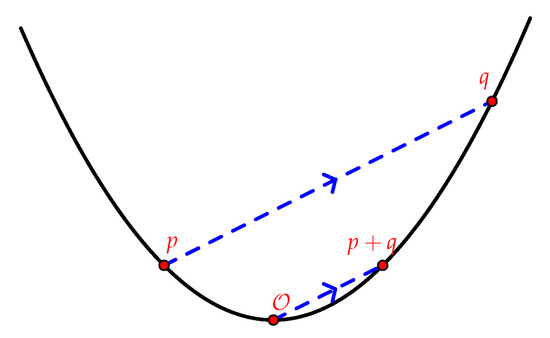
Figure 1.
Addition between two points on a curve when the identity element belongs to the curve.
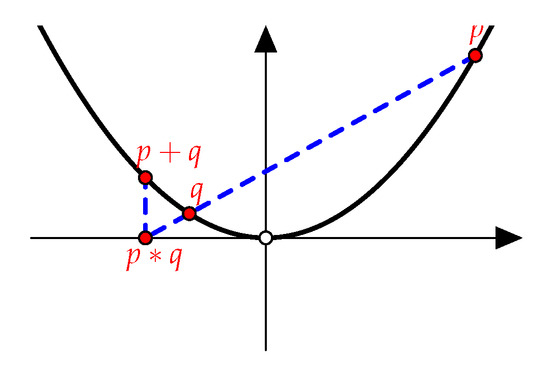
Figure 2.
Addition between two points on a curve when the identity element is at infinity.
If we consider now that the identity element is at infinity, then the sum of two arbitrary points p and q on the conic is the image on the conic of the point obtained as intersection with the x-axis of the line passing through p and q, as shown in Figure 2.
Example 1. 
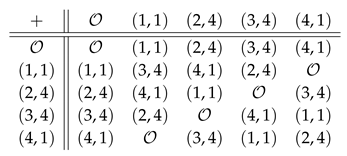
Consider over the finite field . Then we have a parabola in F and the Cayley table of its points where, is the identity element of the group, is as follows.

If we take the identity element at infinity, then the group operation is calculated as in the following Cayley table:

The geometrical interpretation of the associativity of the group law is equivalent with a special case of Pascal’s theorem, which is a very special case of Bezout’s theorem.
Theorem 1.
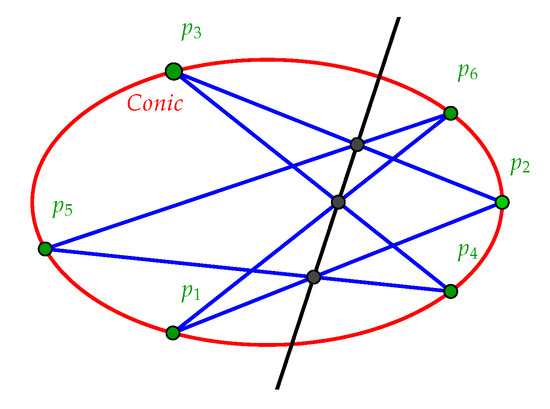
For any conic and any six points on it, the opposite sides of the resulting hexagram, extended if necessary, intersect at points lying on some straight line. More specifically, let denote the line through the points p and q. Then the points , , and lie on a straight line, called the Pascal line of the hexagon (see Figure 3).

Figure 3.
Pascal’s theorem.
2.2. Krasner Hyperrings and Hyperfields
In this section we briefly recall the main definitions and properties of hyperrings and hyperfields, focussing on the concept of Krasner hyperfield.
Let H be a non-empty set and be the set of all non-empty subsets of H. Let ∘ be a hyperoperation (or join operation) on H, that is, a function from the cartesian product into The image of the pair under the hyperoperation ∘ in is denoted by . The join operation can be extended in a natural way to subsets of H as follows: for non-empty subsets of H, define . The notation is used for and for . Generally, we mean (k times), for all and also the singleton is identified with its element a. The hyperstructure is called a semihypergroup if the hyperoperation is associative, i.e., for all , which means that
A semihypergroup is called a hypergroup if the reproduction law holds: , for all .
Definition 1.
Let be a hypergroup and . We say that is a subhypergroup of H, denoted by if for all we have .
An element (respectively ) of H is called a right identity (respectively left identity ) if for all , (respectively ). An element e is called a two side identity, or for simplicity an identity if, for all , A right identity (resp. left identity ) of H is called a scalar right identity (respectively scalar left identity) if for all , (respectively ). An element e is called a scalar identity if for all , An element is called a right inverse (respectively left inverse) of a in H if , for some right identity in H (respectively , for some left identity ). An element is called an inverse of if for some identity e in We denote the set of all right inverses, left inverses and inverses of by and respectively. In addition, if H has a scalar identity, and the inverse of exists, we indicate it by
Definition 2.
A hypergroup H is called reversible, if the following conditions hold:
- (i)
- H has at least one identity e;
- (ii)
- every element x of H has at least one inverse, that is ;
- (iii)
- implies that and , where and .
Definition 3.
Suppose that and are two hypergroups. A function is called a homomorphism if for all a and b in H. We say that f is a good homomorphism if for all a and b in H, there is . Moreover, and are isomorphic, denoted by , if f is a bijective good homomorphism.
An exhaustive review for the theory of hypergroups appears in [9], while the book [12] contains a wealth of applications. The more general algebraic structure that satisfies the ring-like axioms is the hyperring. There are different kinds of hyperrings. The most general one, introduced by Vougiouklis [13], has both addition and multiplication defined as hyperoperations. If only the multiplication is a hyperoperation, then we talk about multiplicative hyperrings [14,15]. If only the addition + is a hyperoperation and the multiplication · is a usual operation, then we say that R is an additive hyperring. A special case of this type is the hyperring introduced by Krasner [6]. An exhaustive review for the theory of hyperrings appears in [16,17,18,19].
Definition 4
([6]). A Krasner hyperring is an algebraic structure which satisfies the following axioms:
- (1)
- is a canonical hypergroup, i.e.,
- (i)
- for every
- (ii)
- for every
- (iii)
- there exists such that for every ,
- (iv)
- for every there exists a unique element such that ; (we shall write for and we call it the opposite of x.)
- (v)
- implies that and .
- (2)
- is a semigroup having zero as a bilaterally absorbing element, i.e., .
- (3)
- The multiplication is distributive with respect to the hyperoperation +.
A Krasner hyperring is called commutative, if is a commutative semigroup with unit element, i.e., a monoid. A Krasner hyperring is called a Krasner hyperfield, if the multiplicative part is a group.
In the following we recall the first construction of a Krasner hyperfield, as a quotient structure of a classical field by a normal subgroup. Let be a field and G be a normal subgroup of where Take with the hyperoperation and the multiplication defined by:
- (i)
- (ii)
for all . Then is a hyperfield. From now on, we denote for all and the constructed hyperfield by and call it the Krasner hyperfield. Moreover, we denote the inverse of relative to ⊕ by and, for the multiplicative inverse by . Besides, we will use the notation and for all .
3. Hyperhomographies
In this section we define the notion of hyperhomography on a Krasner hyperfield, as a quotient structure of a classical field by a normal subgroup. Using it, we introduce some hyperoperations and investigate the properties of the associated hypergroups.
Definition 5.
Let be the Krasner hyperfield associated with the field F and . Define the generalized homography transformation on F as on , and call it the hyperhomography relation. We call the set hyperhomography, while is a homography, for all and .
Notice that the hyperhomography is a generalization of a homography , because is equivalent with , i.e., . The classical operations on the field F have been extended to the hyperoperation ⊕ and operation ⊙ on , where by we denote the hyperaddition between and the opposite of with respect to the hyperoperation ⊕. Besides, since the result of a hyperoperation is a set, the equality relation in the definition of a homography is substitute by a "belongingness" relation in the definition of a hyperhomography.
Moreover denote and , for all It follows that .
Theorem 2.
The relation between homographies and hyperhomographies is given by the following identity
Proof.
. Let thus there exists , such that , hence for some . Then and the following implications hold:
so
. Conversely, suppose that then the following implications hold, too:
therefore and consequently . □
Thanks to Theorem 2, we call the set the hyperhomography on F, while the set is a homography on .
Example 2.
Let be the field of all integers modulo and . Thus the quotient set is and the hyperaddition and the multiplication are defined on as follows: where , and .
where , and .
 where , and .
where , and .Consider now the hyperhomography
and the homographies
Then it follows that
and therefore
as stated by Theorem 2.
Definition 6.
A hyperhomography in is called nondegenerate, if the following conditions hold, respectively:
- (i)
- for all , if , then can be omitted from ,
- (ii)
- for all and there is
- (iii)
- for all the element can be added to where ∞ is an element outside of
By consequence, under the same conditions, also is called a nondegenerate hyperhomography in .
For a nondegenerate hyperhomography in , we fix some new notations: , and , for any .
Example 3.
If we go back to Example 2 and use the concepts in Definition 6, then we can omit from and from , respectively, and add in both sets the element . Then and are nondegenerate homographies, while is a nondegenerate hyperhomography with the property where,
Definition 7.
Let be a nondegenerate hyperhomography in . Setting , we obtain that . Define
for all and , where .
Moreover set , where , for all and .
Corollary 1.
Let be a nondegenerate hyperhomography in and G be a normal subgroup of . If and , then
Proof.
According to Definition 7, if and , then or . In the second case, solving the equation we get . □
In the following, for a nondegenerate hyperhomography in , we define the lines passing through two points.
Definition 8.
Let be a nondegenerate hyperhomography in . For all and , define and
where means the formal derivative of . In addition we call the line passing through the points and Intuitively, for each , the line passing through is a vertical line. In other words, plays an asymptotic extension role for .
Taking two arbitrary points on the homography , define by Using the definition of the lines and , for we have
where,
and hence If or are equal to according to Definition 8, we have
Thus and is well defined, therefore we have
We will better illustrate the above defined notions in the following example.
Example 4.
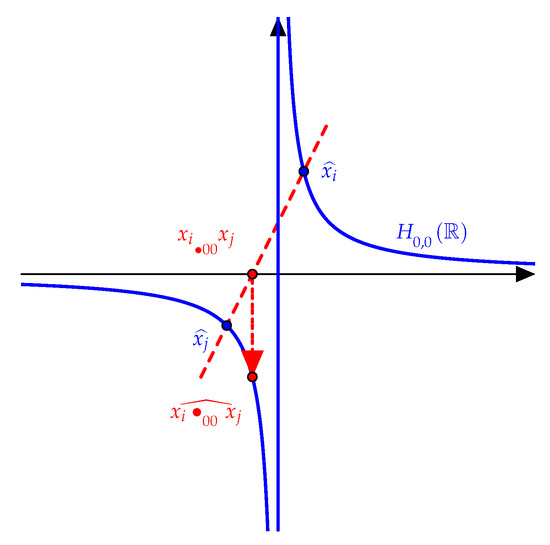
Consider the field and the homography transformation over F, so its graph is the hyperbola represented below in Figure 4. Taking on two arbitrary points and , we draw the line passing through and . Then , where is the x-axis. Then we obtain the point on the hyperbola .

Figure 4.
Hyperbola .
Proposition 1.
Let be a nondegenerate hyperhomography in and . Then, it follows that
Proof.
Based on Definition 8 and on the fact that and , by simple computations, we obtain
□
Remark 1.
is a homography group, for all . Moreover, notice that "" is the group operation on the homography
On a nondegenerate hyperhomography in we introduce the equivalence relation “∼” by considering
and denote the set of the equivalence classes of and by and , respectively. It follows that
Furthermore, if we introduce the notation and We will have , and
Thus and are called the equipped hyperhomographies in and , respectively. Besides, if we admit that for all and , then the bijective map defined by , where equip the quotient with a group structure and gives us a group isomorphism
In addition, the concepts in Definition (8) can be similarly defined on , only by substituting a with .
Definition 9.
Let be an equipped hyperhomography. We define the hyperoperation "∘" on as follows.
Let . If and for some and , then
Theorem 3.
If is an equipped hyperhomography, then has a hypergroup structure.
Proof.
Suppose that such that and where, . First we notice that because implies that , i.e is a non-empty set and belongs to Besides, if and , then and , meaning that and . Hence we have and therefore , equivalently with . By consequence, the hyperoperation “∘” is well defined.
If or or then the associativity is obvious. If not, we have the following cases.
Case 1: .
This means that and we have
Similarly, it holds that
On the other hand we have
In other words, for the six points , , , , and on the curve we have and and therefore, by Pascal’s theorem (see Theorem 1), it follows also that , equivalently with
By Definition 8 we know that
where, by the associativity of the group operation "", it holds This leads to the equality
implying that
Case 2: .
(i) If , then we have
On the other hand
(ii) If , then the associativity holds, similarly as in the case (i).
(iii) If , then we have
and similarly
Case 3: .
In this case we have
On the other hand
Therefore the hyperoperation "∘" is associative.
In order to prove the reproduction axiom, we consider two cases as below:
Case 1. If , then and where . It follows that is a homography group, so the reproduction axiom holds.
Case 2. If consider an arbitrary element . Then
Similarly, and thus the reproduction axiom is proved. Therefore, is a hypergroup. □
Remark 2.
If , then the hyperhomography and the associated hypergroup are the classical homography and the homography group, respectively.
Example 5. 
Let us consider again Example 3, where we deal with the nondegenerate hyperhomography as a subset of , having the form where, and , while the associated equipped hyperhomography is where,
for
Now let and Then and are reversible subhypergroups of , which are defined by the following Cayley tables, respectively

For a better understanding, we will explain all details in computing, for example, in the table of T the hyperproduct . For doing this, since , we use the function and the field . Based on Corollary 1, we obtain
and therefore,
Based on Proposition 1, we have
which imply that
Similarly, all the other hyperproducts in both tables can be obtained.
The next result gives a characterization of the subhypergroups of the equipped hyperhomographies in .
Theorem 4.
Let H be a non-empty subset of the hypergroup . Then H is a subhypergroup of the equipped hyperhomography if and only if it can be written as , where , or H is a subhypergroup of , for some .
Proof.
. Suppose that H is a subhypergroup of and , for every in . There exist in such that . Now let . Thus we have . Hence .
. It is obvious. □
Theorem 5.
Let H be a subhypergroup of the hypergroup . Then H is reversible if and only if H is a subhypergroup of , for some .
Proof.
. First we prove that any subhypergroup H of is a regular reversible hypergroup, for any . The regularity is clear, because is an identity and each element is an inverse for itself. In order to prove the reversibility, let and be arbitrary elements in . We distinguish three different situations.
Case 1. If , where , then
Case 2. If , then , with . Thus . It follows that .
Case 3. If , then , implying that and . Notice that , for all (i.e. every element is one of its inverses).
. Suppose that H is a reversible subhypergroup of such that it is not a subhypergroup of any , with . Based on Theorem 4, we have , where . Let be arbitrary elements in and , respectively, that are not equal to , with . If , then, based on the reversibility, we have , where , hence . Thus , which is in contradiction with the supposition that . Therefore , for some . □
In the following we will present two new hypergroup structures isomorphic with the equipped homography in the case when and , respectively.
Theorem 6.
Consider the field F and define on the hyperoperation
Then, for every , there is the homomorphism .
Proof.
It is easy to see that is a hypergroup. Now, taking , consider the bijective function defined by and the function defined by , where and . Geometrically, is the graph of the function , thus it is the line passing through the points of and , while is the map that projects the points of the hyperhomography on the above mentioned line.
Thus, using Proposition 1, for all we have
Now suppose that are arbitrary elements in . It follows that
Take now with as the projection map on the second component and define by .
We have , for all , thus is a bijective map and also a homomorphism because
Therefore is isomorphic to □
Theorem 7.
Consider the field F and define on the hyperoperation
Then, if , there is the homomorphism .
Proof.
Clearly, is a hypergroup. Consider the bijective function defined by and be its graph. Besides define by , where . Therefore, for all we have
and for all
As in the previous theorem, let , be the projection map on second component and define by .
Therefore, for all , and thus is a bijective map. We claim that is a homomorphism, too, because
Therefore is isomorphic with . □
4. Associated -Groups
Vougiouklis [13] introduced the notion of group as a generalization of the notion of hypergroup, substituting the associativity of the hyperoperation with the weak associativity, i.e., for all . The motivation of introducing this hyperstructure is the following one. We know that the quotient of a group with respect to a normal subgroup is a group, while the quotient of a group with respect to any subgroup is a hypergroup. Vougiouklis stated that the quotient of a group with respect to any partition of the group is an group.
In the following we equip the hyperhomography as a subset of with an group structure, by defining the following hyperoperation
Notice that
and
Moreover according with Thorem 2, the hyperoperation is well defined on and in addition we have
Proposition 2.
is an -group.
Proof.
Let , and be elements in Then we have
□
Proposition 3.
Let , . Then is an epimorphism of -groups.
Proof.
Suppose that and belong to We have
□
Example 6. 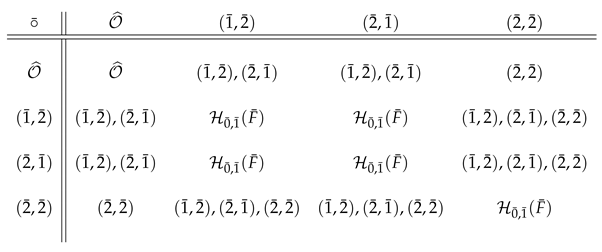
If we consider the hyperhomography , then after long calculations similarly s those in Example 5, we get the following -group table.

Proposition 4.
On , as a subset of , define the hyperoperation
Then is an .
Proof.
First we prove that, if and , then To this aim, consider an arbitrary element not equal to and notice that . Then
Consequently, for all and “⋅” is well defined. Now, let belong to . We get
thus the weak associativity condition holds. It can easily be seen that the reproduction axiom is valid, too. □
Example 7. 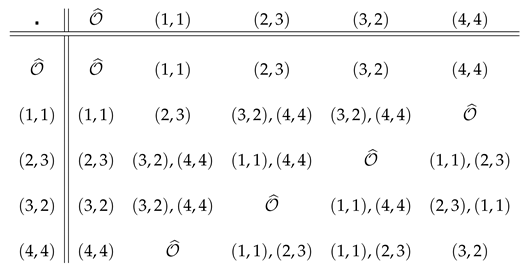
The Cayley table of the group where, is again the field of order 5, is as follows:

In this table, we have , for all and
for all The hyperoperation is not associative, but only weak associative, as we can notice here below:
5. Conclusions
In the last few years, researchers in the hypercompositional structure theory have investigated, principally from a theoretical point of view, all types of hyperrings: general hyperrings [20], multiplicative hyperrings [15], additive hyperrings [21], superrings [22], but till now, only the Krasner hyperrings have found interesting and useful applications in number theory, algebraic geometry, scheme theory, as mentioned in the introductory part of this article. Here the authors continue the study on the research topic started in [1] about elliptic hypercurves defined on quotient Krasner hyperfield, with applications in cryptography [8]. In a similar way, the notion of a homography on a field is extended to hyperhomography over Krasner hyperfields. More exactly, considering an arbitrary field F and a normal subgroup G of its multiplicative group, we get a Krasner hyperfield . Then the homography , where is naturally extended to the hyperhomography over the hyperfield . Besides, the group operation on a homography leads to a hyperoperation on the associated equipped hyperhomography , that becomes a hypergroup. Then, all reversible subhypergroups of an equipped hyperhomography are characterized. In the last part of the paper, other hyperoperations are defined on hyperhomographies and their properties are investigated in connection with weak associativity.
Author Contributions
Conceptualization, V.V., M.J. and I.C.; Funding acquisition, I.C.; Investigation, V.V. and M.J.; Methodology, I.C.; Writing —original draft, V.V. and M.J.; Writing—review & editing, I.C.
Funding
The third author acknowledges the financial support from the Slovenian Research Agency (research core funding No. P1 - 0285).
Conflicts of Interest
The authors declare no conflict of interest.
References
- Vahedi, V.; Jafarpour, M.; Aghabozorgi, H.; Cristea, I. Extension of elliptic curves on Krasner hyperfields. Commun. Alg. 2019, 47, 4806–4823. [Google Scholar] [CrossRef]
- Connes, A.; Consani, C. The hyperring of adele classes. J. Number Theory 2011, 131, 159–194. [Google Scholar] [CrossRef]
- Al Tahan, M.; Davvaz, B. On the existence of hyperrings associated with arithmetic functions. J. Number Theory 2017, 174, 136–149. [Google Scholar] [CrossRef]
- Viro, O. On basic concepts of tropical geometry. Proc. Steklov Inst. Math. 2011, 273, 252–282. [Google Scholar] [CrossRef]
- Jun, J. Algebraic geometry over hyperrings. Adv. Math. 2018, 323, 142–192. [Google Scholar] [CrossRef]
- Krasner, M. A class of hyperrings and hyperfields. Int. J. Math. Math. Sci. 1983, 6, 307–311. [Google Scholar] [CrossRef]
- Massouros, C.G. On the theory of hyperrings and hyperfields. Algebra i Logika 1985, 24, 728–742. [Google Scholar] [CrossRef]
- Berardi, L.; Eugeni, F.; Innamorati, S. Remarks on Hypergroupoids and Criptography. J. Combin. Inf. Syst. Sci. 1992, 17, 217–231. [Google Scholar]
- Corsini, P. Prolegomena of Hypergroup Theory; Aviani Editore: Tricesimo, Italy, 1993. [Google Scholar]
- Hankerson, D.; Menezes, A.; Vanstone, S.A. Guide to Elliptic Curve Cryptography; Springer: Berlin, Germany, 2004. [Google Scholar]
- Koblitz, N. Introduction to Elliptic Curves and Modular Forms; Volume 97 of Graduate Texts in Mathematics; Springer: New York, NY, USA, 1984. [Google Scholar]
- Corsini, P.; Leoreanu, V. Applications of Hyperstructure Theory; Kluwer Academic Publications: Dordrecht, The Netherlands, 2003. [Google Scholar]
- Vougiouklis, T. The fundamental relation in hyperrings. The general hyperfield. In Proceedings of the 4th International Congress on Algebraic Hypergroups and Applications, Xanthi, Greece, 27–30 June 1990; World Scientific: Singapore, 1991; pp. 209–217. [Google Scholar]
- Rota, R. Sugli iperanelli moltiplicativi. Rend. Mate 1982, 7, 711–724. [Google Scholar]
- Ameri, R.; Kordi, A.; Hoskova-Mayerova, S. Multiplicative hyperring of fractions and coprime hyperideals. An. Ştiinţ. Univ. Ovidius Constanţa Ser. Mater. 2017, 25, 5–23. [Google Scholar] [CrossRef]
- Davvaz, B.; Leoreanu-Fotea, V. Hyperring Theory and Applications; International Academic Press: Cambridge, MA, USA, 2007. [Google Scholar]
- Nakassis, A. Recent results in hyperring and hyperfield theory. Int. J. Math. Math. Sci. 1988, 11, 209–220. [Google Scholar] [CrossRef]
- Cristea, I.; Jančić-Rašović, S. Composition hyperrings. An. Şt. Univ. Ovidius Constanţa 2013, 21, 81–94. [Google Scholar] [CrossRef]
- Norouzi, M.; Cristea, I. Hyperrings with n -ary composition hyperoperation. J. Alg. Appl. 2018, 17, 1850022. [Google Scholar] [CrossRef]
- Norouzi, M.; Cristea, I. Fundamental relation on m-idempotent hyperrings. Open Math. 2017, 15, 1558–1567. [Google Scholar] [CrossRef]
- Bordbar, H.; Cristea, I.; Novak, M. Height of hyperideals in Noetherian Krasner hyperrings. Politehn. Univ. Bucharest Sci. Bull. Ser. A Appl. Math. Phys. 2017, 79, 31–42. [Google Scholar]
- Ameri, R.; Eyvazi, M.; Hoskova-Mayerova, S. Superring of polynomials over a hyperring. Mathematics 2019, 7, 902. [Google Scholar] [CrossRef]
© 2019 by the authors. Licensee MDPI, Basel, Switzerland. This article is an open access article distributed under the terms and conditions of the Creative Commons Attribution (CC BY) license (http://creativecommons.org/licenses/by/4.0/).